| CPC G06T 17/10 (2013.01) [G06T 15/04 (2013.01); G06T 15/205 (2013.01); G06T 19/20 (2013.01); G06T 2219/2004 (2013.01)] | 19 Claims |

|
1. A computer-implemented method, comprising:
receiving a two-dimensional (“2D”) partial body image of a human body from a 2D camera, wherein the 2D partial body image represents less than all of the human body;
processing the 2D partial body image to at least:
generate a first body segment including a first plurality of pixels of the 2D partial body image that represent a first segment of the human body;
generate a second body segment including a second plurality of pixels of the 2D partial body image that represent a second segment of the human body that is different than the first segment of the human body;
determine a third plurality of pixels of the 2D partial body image that do not represent the human body;
determine a first plurality of 2D landmarks corresponding to the human body that are visible in the 2D partial body image; and
determine a second plurality of 2D landmarks corresponding to the human body that are not visible in the 2D partial body image;
generating, based at least in part on the first body segment, the second body segment, and the first plurality of 2D landmarks, a three-dimensional (“3D”) model of the human body, wherein the 3D model includes at least:
a first 3D model segment corresponding to the first segment;
a second 3D model segment corresponding to the second segment; and
a third 3D model segment corresponding to a portion of the human body that is not visible in the 2D partial body image;
comparing the first 3D model segment and the second 3D model segment with at least one of the 2D partial body image or the first body segment and the second body segment to determine a difference between the 3D model and the at least one of the 2D partial body image or the first body segment and the second body segment; and
adjusting at least one of the first 3D model segment, the second 3D model segment, or the third 3D model segment based at least in part on the difference to produce a revised 3D model of the human body.
|